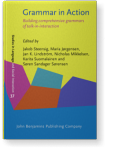Chapter 12
Action formation, projection, and participation framework
Pseudoclefts in Swedish talk-in-interaction
This chapter discusses the structural, interactional and
situational specifics of the pseudo-cleft construction in Swedish
talk-in-interaction, specifying its use as a resource for turn and
action formation but also as a means to regulate discursive
trajectories and the participation framework. An analysis of nearly
100 instances of pseudoclefts collected from casual conversations
and institutional interactions revealed that this format is a
recognizable and conventionally available building block of
interaction exhibiting a regular grammatical pattern which can be
characterized as a compound turn constructional unit. The
pseudocleft is used for discourse organization in marking
transitions in the pragmatic course of an interaction. This gives
the construction a projecting force on the level of sequence
organization. Our analysis illustrates that pseudoclefts are not
dedicated to accomplishing one single kind of action but typically
contribute to the formation of directive-commissive and evaluative
actions. The pseudoclefts in our datasets were often used by
participants to claim an expert position. This implies a rather
strong link between the grammatical format and the participation
framework in which the format casts one of the participants as
possibly more knowledgeable and as the one who controls the agenda,
has the right to direct others, and to make assessments.
Article outline
- 1.Introduction
- 2.Turn design
- 2.1Grammatical structure
- 2.1.1Standard structure
- 2.1.2Structural variation
- 2.2Information structure and projection
- 3.Sequence and action formation
- 3.1Accomplishing directive-commissive and evaluative social
actions
- 3.2Initiating discursive transitions
- 4.Participation framework and epistemic positioning
- 5.Conclusion and outlook
-
Acknowledgements
-
Notes
-
References
-
Appendix
This content is being prepared for publication; it may be subject to changes.
